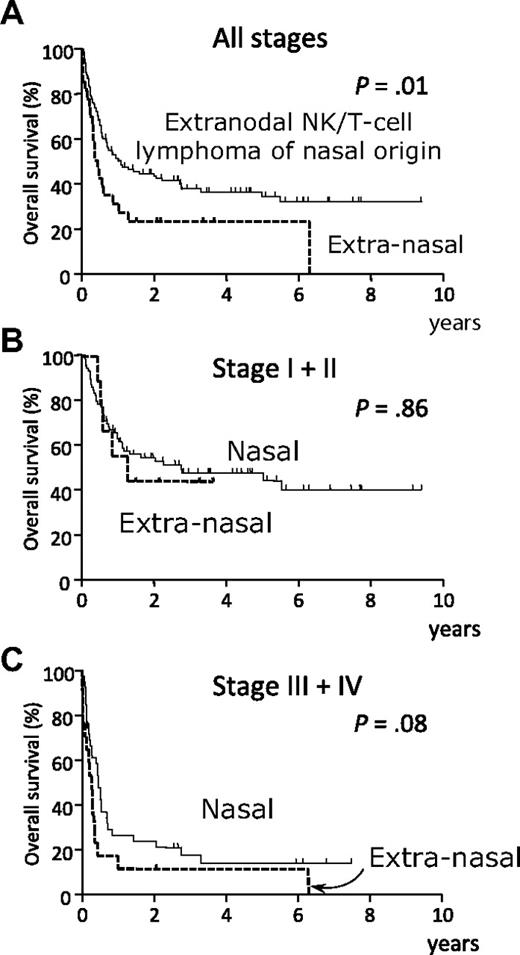To the editor:
We read with interest the results of the peripheral T-cell lymphoma (PTCL) classification project reported by Au et al, which stated that prognosis of extranodal natural killer (NK)/T-cell lymphoma (ENKL) of nasal origin is different from that of extranasal origin.1 They further concluded these 2 subtypes of ENKL are different entities.
We principally agree with their conclusion, but the prognostic difference they pointed out needs further estimation. Our data on 150 ENKLs (123 nasal and 27 extranasal)2 also demonstrate the same results if analyzed as a whole (Figure 1A). However, the proportion of localized versus advanced stage of disease is completely different between nasal and extranasal origins. Patients who initially presented with localized disease (clinical stage I or II) included 84 (68%) of those with ENKL of nasal origin, but only 10 (37%) of those with ENKL of extranasal origin. This difference is also documented in the literature,3-5 as well as in the result from the PTCL project.1 Notably, the prognostic difference disappeared after stratification by clinical stage (Figure 1B,C). We absolutely agree with the notion of Au et al that clinical behaviors of nasal and extranasal ENKLs are significantly different, but we should aware that the prognostic difference is derived from the different extent of each disease.
Prognosis of extranodal NK/T-cell lymphoma (ENKL). (A) ENKLs of nasal origin show better prognosis than that of extranasal origin (P = .01). (B) When restricted to limited stages (I + II), the prognosis of nasal and extranasal ENKLs are almost the same (P = .86). (C) For advanced stages (III + IV), there is no statistical difference (P = .08).
Prognosis of extranodal NK/T-cell lymphoma (ENKL). (A) ENKLs of nasal origin show better prognosis than that of extranasal origin (P = .01). (B) When restricted to limited stages (I + II), the prognosis of nasal and extranasal ENKLs are almost the same (P = .86). (C) For advanced stages (III + IV), there is no statistical difference (P = .08).
Authorship
Conflict-of-interest disclosure: K.O. is currently an employee of Eisai Pharmaceutical Company (Woodcliff Lake, New Jersey). The remaining authors declare no competing financial interests.
Correspondence: Ritsuro Suzuki, MD, Department of HSCT Data Management, Nagoya University, School of Medicine, 1-1-20 Daiko-Minami, Higashi-ku, Nagoya, 461-0047 Japan; e-mail: r-suzuki@med.nagoya-u.ac.jp.


